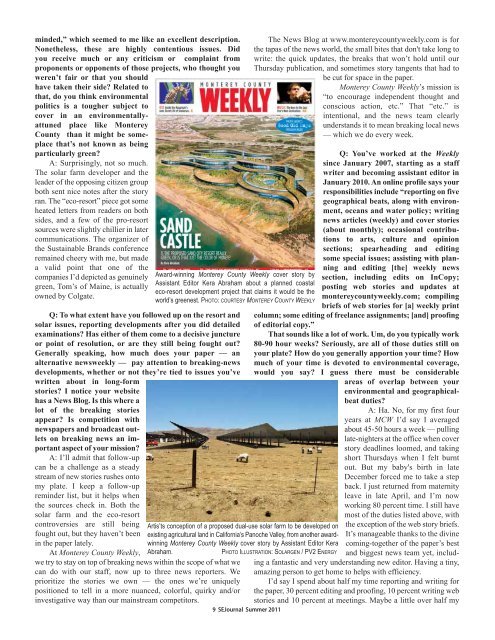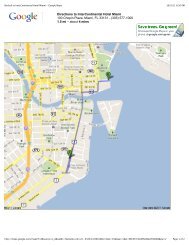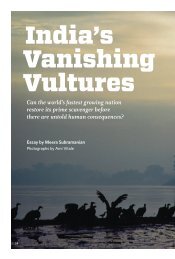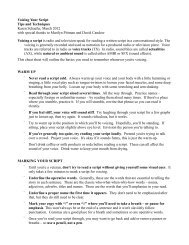ournal - Society of Environmental Journalists
ournal - Society of Environmental Journalists
ournal - Society of Environmental Journalists
- No tags were found...
Create successful ePaper yourself
Turn your PDF publications into a flip-book with our unique Google optimized e-Paper software.
minded,” which seemed to me like an excellent description.Nonetheless, these are highly contentious issues. Didyou receive much or any criticism or complaint fromproponents or opponents <strong>of</strong> those projects, who thought youweren’t fair or that you shouldhave taken their side? Related tothat, do you think environmentalpolitics is a tougher subject tocover in an environmentallyattunedplace like MontereyCounty than it might be someplacethat’s not known as beingparticularly green?A: Surprisingly, not so much.The solar farm developer and theleader <strong>of</strong> the opposing citizen groupboth sent nice notes after the storyran. The “eco-resort” piece got someheated letters from readers on bothsides, and a few <strong>of</strong> the pro-resortsources were slightly chillier in latercommunications. The organizer <strong>of</strong>the Sustainable Brands conferenceremained cheery with me, but madea valid point that one <strong>of</strong> thecompanies I’d depicted as genuinelygreen, Tom’s <strong>of</strong> Maine, is actuallyowned by Colgate.Q: To what extent have you followed up on the resort andsolar issues, reporting developments after you did detailedexaminations? Has either <strong>of</strong> them come to a decisive junctureor point <strong>of</strong> resolution, or are they still being fought out?Generally speaking, how much does your paper — analternative newsweekly — pay attention to breaking-newsdevelopments, whether or not they’re tied to issues you’vewritten about in long-formstories? I notice your websitehas a News Blog. Is this where alot <strong>of</strong> the breaking storiesappear? Is competition withnewspapers and broadcast outletson breaking news an importantaspect <strong>of</strong> your mission?A: I’ll admit that follow-upcan be a challenge as a steadystream <strong>of</strong> new stories rushes ontomy plate. I keep a follow-upreminder list, but it helps whenthe sources check in. Both thesolar farm and the eco-resortcontroversies are still beingfought out, but they haven’t beenin the paper lately.At Monterey County Weekly,Award-winning Monterey County Weekly cover story byAssistant Editor Kera Abraham about a planned coastaleco-resort development project that claims it would be theworld’s greenest. PHOTO: COURTESY MONTEREY COUNTY WEEKLYArtis’ts conception <strong>of</strong> a proposed dual-use solar farm to be developed onexisting agricultural land in California’s Panoche Valley, from another awardwinningMonterey County Weekly cover story by Assistant Editor KeraAbraham.PHOTO ILLUSTRATION: SOLARGEN / PV2 ENERGYwe try to stay on top <strong>of</strong> breaking news within the scope <strong>of</strong> what wecan do with our staff, now up to three news reporters. Weprioritize the stories we own — the ones we’re uniquelypositioned to tell in a more nuanced, colorful, quirky and/orinvestigative way than our mainstream competitors.9 SEJ<strong>ournal</strong> Summer 2011The News Blog at www.montereycountyweekly.com is forthe tapas <strong>of</strong> the news world, the small bites that don't take long towrite: the quick updates, the breaks that won’t hold until ourThursday publication, and sometimes story tangents that had tobe cut for space in the paper.Monterey County Weekly’s mission is“to encourage independent thought andconscious action, etc.” That “etc.” isintentional, and the news team clearlyunderstands it to mean breaking local news— which we do every week.Q: You’ve worked at the Weeklysince January 2007, starting as a staffwriter and becoming assistant editor inJanuary 2010. An online pr<strong>of</strong>ile says yourresponsibilities include “reporting on fivegeographical beats, along with environment,oceans and water policy; writingnews articles (weekly) and cover stories(about monthly); occasional contributionsto arts, culture and opinionsections; spearheading and editingsome special issues; assisting with planningand editing [the] weekly newssection, including edits on InCopy;posting web stories and updates atmontereycountyweekly.com; compilingbriefs <strong>of</strong> web stories for [a] weekly printcolumn; some editing <strong>of</strong> freelance assignments; [and] pro<strong>of</strong>ing<strong>of</strong> editorial copy.”That sounds like a lot <strong>of</strong> work. Um, do you typically work80-90 hour weeks? Seriously, are all <strong>of</strong> those duties still onyour plate? How do you generally apportion your time? Howmuch <strong>of</strong> your time is devoted to environmental coverage,would you say? I guess there must be considerableareas <strong>of</strong> overlap between yourenvironmental and geographicalbeatduties?A: Ha. No, for my first fouryears at MCW I’d say I averagedabout 45-50 hours a week — pullinglate-nighters at the <strong>of</strong>fice when coverstory deadlines loomed, and takingshort Thursdays when I felt burntout. But my baby's birth in lateDecember forced me to take a stepback. I just returned from maternityleave in late April, and I’m nowworking 80 percent time. I still havemost <strong>of</strong> the duties listed above, withthe exception <strong>of</strong> the web story briefs.It’s manageable thanks to the divinecoming-together <strong>of</strong> the paper’s bestand biggest news team yet, includinga fantastic and very understanding new editor. Having a tiny,amazing person to get home to helps with efficiency.I’d say I spend about half my time reporting and writing forthe paper, 30 percent editing and pro<strong>of</strong>ing, 10 percent writing webstories and 10 percent at meetings. Maybe a little over half my












